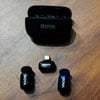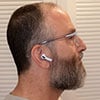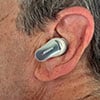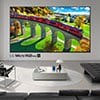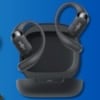Mark Zuckerberg is the principal proselytizer who predicts that smart glasses are poised to replace smartphones as our key personal communication and computing tool within the next decade or so. Wishful thinking IMHO, but current early generation smart glasses do provide tangible benefits for the vision and hearing impaired.
Smart glasses’ potential as accessibility aids is especially apparent in the new Rokid Glasses, now available for $549 on Kickstarter, $599 when they hit the open market.
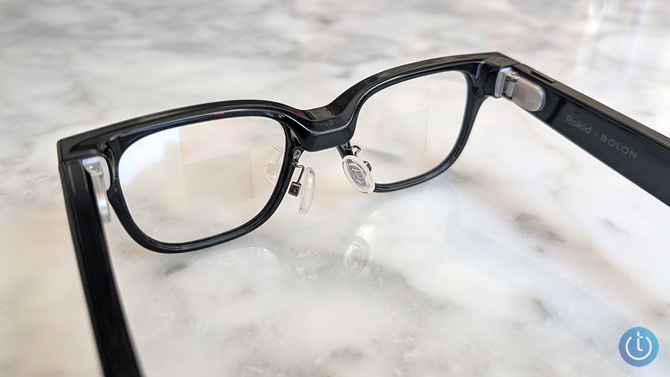
Founded in 2014 in Hangzhou, China, Rokid has been working on smart glasses since 2018. Rokid believes its latest iteration is the most advanced and real-world functional smart glasses yet available.
What sets the Rokid Glasses apart from other current smart spectacles is its innovative heads-up display. Translations, texts, and all other otherwise spoken responses show up in green type on the lenses right in front of your eyes.
We’re waiting for our review sample to compare them to the Meta glasses, which start at $299, the Amazon Echo Frames ($329), and, the sub-$100 Vital Smart Glasses (no camera), all of which offer/promise similar feature sets – but without Rokid Glass’ distinctive heads-up display.
Rokid Glasses Basics and Specs
Thanks to access to OpenAI (ChatGPT), Microsoft, Garmin Health, and Google Maps, and Qualcomm’s new Snapdragon AR1 processor, Rokid can display real-time translation of 89 languages with more to come, lyrics to music being played, object identification, GPS directions, and even a TV-like teleprompter for public speaking or presentations.
Like most smart glasses, Rokid Glasses are Clark Kent-like thick and piano lacquer black, what most folks would consider nerdy. This is necessary to hide the circuitry and electronics hidden within the glasses’ frame and temples. At present, Rokid Glasses are available only in one size that could look outsized on smaller faces.

For sight and sound, the Rokid Glasses are equipped with a front-facing camera to capture 12MP still pictures and 1680p, 60 frame-per-second video in 4:3, 3:4, and 9:16 aspect ratios enhanced with low light HDR. The glasses can store up to 32GB of video, which is automatically synced/transferred to Rokid’s smartphone app.
To ensure privacy in potentially morally or legally questionable situations, covering the “recording on” LED on the front of the glasses will automatically disable the camera.
Built into the glass’ temples – the earpieces – are four microphones and dual-directional dual-driver open near-ear AAC speakers.
The glasses weigh 49 grams, the same as Meta’s Ray-Ban models.
Rokid’s Achilles heel functionally is battery life. Rokid claims its glasses provide “all-day” battery life from its necessarily compact 210 mAh battery, but a demonstrator admitted to only seven to eight hours on standby, with five hours for music listening, and 20 minutes for video. This short battery life means anyone relying on accessing the Rokid’s capabilities “all day” will have to set aside recharging time at least twice during waking hours, not exactly a convenience for those needing to wear corrective lenses all day.
Which leads us to…
Rokid Solves Smart Glasses Prescription Lens Problem
For any smart glasses to aid the vision impaired, they first must be able to accommodate prescription lenses. Given the number of us who need corrective lenses – according to the Vision Council, an estimated two-thirds of Americans wear glasses or contacts – prescriptive lens solutions for smart glasses aren’t exactly available, elegant, or cheap.
As anyone who wears glasses knows, prescription lenses can get really expensive, almost always pricier than the frames – unless you buy your glasses online from providers who make their own frames, such as Zenni, rather than from the near-monopolistic frames provider EssilorLuxottica. While competition and volume sales are likely to eventually drive down the cost of smart glasses, prescription lenses are not apt to get any cheaper.
Of course, first you’ll need your prescription, either procured separately or via an eye test from an optometrist partnered with a smart glasses vendor. For instance, you can buy Meta glasses fitted with prescription lenses at LensCrafters or Cohen’s Fashion Optical, while Amazon Echo frames can be bought and fitted with prescription lenses at opticians such as America’s Best.
As any glasses wearer can tell you, few if any optometrists will fit prescription lenses into frames not originally purchased from them. However, LenCrafters told me that I can call or bring in a new prescription for my existing Meta Ray-Bans smart glasses. When the new lenses arrive, they’ll fit my existing Meta frames with the new lenses while I wait. My LensCrafters’ replacement multifocal lenses will cost me around $500, though. That’s right – the lenses, two thin pieces of plastic, will cost nearly twice as much as the sophisticated smart glasses they are being fit into. America’s Best needs to send my Amazon Echo smart glasses out to be refit with new lenses, which could take two or three weeks and will cost around half as much as LensCrafters’ replacement lenses. Obviously, each optometrist will have their own lens refit policies and prices.
Rokid has come up with a clever solution to these prescriptive lens issues. Instead of having to go to a participating optician to get prescription lenses fitted into a smart glasses frame, you separately order your prescription lenses, which you can magnetically clip inside the Rokid frame yourself, right behind the existing heads-up display lenses.
Not only is this a smoother and easier prescription lens procedure, but the issue of getting updated prescription lenses becomes easier and cheaper since all you’re doing is getting the new prescription lenses and clipping them in yourself.
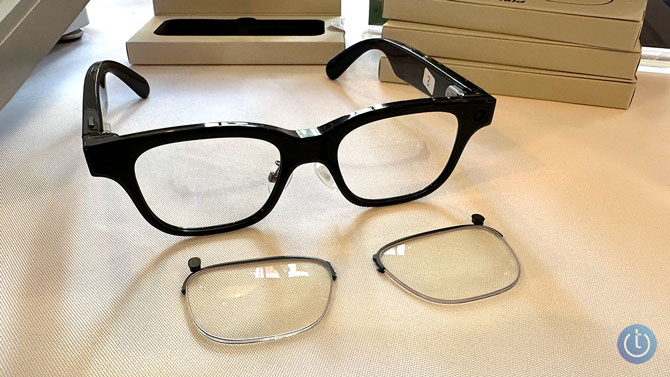
Of course, wearing two sets of lenses means you now must strive to keep both clean. If you then add Rokid’s front-mounted magnetic clip-on sunglasses, due to be available later this fall, you’ll have a third set of lenses to keep clean.
Unfortunately, Rokid hasn’t quite got its prescription lenses bit all figured out yet, at least in the U.S. First, Rokid doesn’t know how much these add-on prescription lenses will cost, although I get the sense that they’ll be cheaper than from retail opticians because they’ll be coming from Rokid themselves. The company currently has two Asian-based prescription lenses suppliers, but Rokid is seeking a certified prescription lenses partner, including those who can support multi-focal options in the U.S.
When Rokid gets its U.S. prescription lens act together, its smart glasses suddenly become a far more viable aid for the bulk of humanity suffering vision impairment.
Boon for the Vision and Hearing-Impaired?
Other than overcoming the hurdle of adding prescription lenses to smart glasses, is there an actual boon for the vision-impaired? Yes, but smart glasses accessibility aids for those of us with less than 20/20 vision are pretty similar to those of us with, well, less than 20/20 hearing.
If you have diminished hearing, like I do, you likely love closed captioning on TV, whether we’re wearing hearing aids or not. Rokid makes closed captioning available in real life.
How?
Since Rokid enables you to choose which languages can be translated into which languages, all you need to do is set the app’s translation to the same language – i.e. English → English – to get a running closed captioning of conversation.
Rokid claims that translations happen in real time, instantaneously, which I prefer to be skeptical about until I get a chance to test this myself. It likely requires an internet connection to provide translations that quickly. In the real world, I’ll still need a second to read the closed-captioning, a pregnant pause that might need explaining during a conversation in a noisy environment – but at least I’ll have a better idea of what’s being said to me.
In addition, to avoid possible multi-participant translation confusion, the glasses’ directional microphones focus on the person in front of you so the Glasses transcribe only what that person is saying. How they handle transcription for multi-way conversations literally remains to be seen.
In addition to translating spoken text, Rokid glasses also translate text. For the vision impaired, hard-to-read printed text or menus in a dark restaurant can now be displayed brightly right before your eyes.
Not only can the hyperopia – farsighted – get tiny text appear before their eyes, you can customize the text font size, position in the display (below line of sight or in line of sight), and the number of lines (from one up to five) in the Rokid smartphone app. In addition, you can choose a subtitle-style view and larger blocks of text, depending on your vision needs.
Seeing text that up-close and in a text size and form that is easiest to read for you is an absolute miracle not only for the far-sighted but also for avid readers who frustratingly suffer from glaucoma, macular degeneration, or other clouded vision conditions – if everything works as Rokid says it will.
Replacement or Accessory?
To me, the idea that smart glasses will ever replace smartphones is absurd. Smart glasses suffer from too many inconveniences that keep a lot of devices from becoming mainstream, much less a replacement for the single most popular device in tech history.
First is the lack of true “all-day” battery life, a requirement for folks who need to wear glasses all the time, which is the bulk of potential smart glasses buyers. After all, who ever heard of having to take time out to recharge your glasses?
Next is the difficult and costly procurement, installation, and updating of prescription lenses for smart glasses.
Another issue is humankind’s repeated rebuke of techno-glasses, all the failed efforts of getting folks to wear 3D glasses at home, the lack of interest in personal home theater goggles/glasses, the failure of VR to go mass market, and the less said about the fiasco of Google Glass a decade ago, the better.
Finally, there’s the primal dislike of those of us who wear glasses to actually have to wear glasses. Plainly put, no one who wears glasses wants or likes to wear glasses. To avoid wearing glasses, more than 40 million LASIK procedures have been performed, and about 140 million people – including Zuckerberg himself! – wear contact lenses. And how many celebrities – or people you know – who have to wear glasses but often don’t because they don’t like how glasses make them look?
All of which means that smart glasses are more likely to become an occasional use, situationally-based smartphone accessory. This especially holds true for both the vision and hearing-impaired, if Rokid’s features work as advertised and are adopted by other smart glasses vendors.
Thankfully, as with all new tech, smart glasses tech will continue to evolve and improve, including battery life, to make smart glasses a boon for all.
[Image credit: Techlicious]

